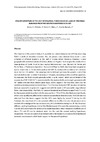Identificador persistente para citar o vincular este elemento:
https://accedacris.ulpgc.es/jspui/handle/10553/19915
| Título: | Paleotemperature of the last interglacial period based on δ18O of Strombus bubonius from the western Mediterranean Sea | Autores/as: | Cornu, Sophie Pätzold, Jürgen Bard, Edouard Meco, Joaquin Cuerda-Barcelo, Juan |
Clasificación UNESCO: | 2416 Paleontología 250205 Paleoclimatología |
Fecha de publicación: | 1993 | Publicación seriada: | Palaeogeography, Palaeoclimatology, Palaeoecology | Resumen: | The objective of the present study is to quantify sea surface temperature (SST) by measuring δ18O in shells of Strombus bubonius. First we present data obtained from modern shells collected at different locations in the Gulf of Guinea where Strombus bubonius is now geographically restricted (islands of Corisso, Bioko and Pagalu). Next we give the results of our investigations of fossils found in two classical Mediterranean sites: Monastir in Tunisia and Palma Nova, a Pleistocene deposit on the island of Majorca. Both sites have been assigned an age corresponding to the last interglacial period (LIP) by stratigraphic correlation with terraces dated by the UTh method. The sampling scheme followed precisely the growth spiral of the mollusk shell in order to obtain time series of 3–4 years, depending on the size of the specimen. As expected, the δ18O records generally exhibit a cyclic pattern which can attributed of the seasonality of SST. δ18O-SST's reconstructed for the modern shells are in rough agreement with SST values obtained from climatological maps, which suggests that Strombus shells may be useful in paleotemperature reconstructions. The difference between δ18O maxima and minima (isotopic seasonality) is generally in aggreement with the modern SST seasonality range inferred from climatological data. This δ18O-SST seasonal temperature difference ranges from 2°C to 6°C for the modern shells from the Gulf of Guinea and from 7°C to 9°C for the Mediterranean fossils, which is not significantly different from modern seasonality at these locations. The δ18O records obtained from the fossils suggest that the SST's were higher by several °C during the LIP. However, the magnitude of this temperature difference is difficult to quantify precisely due to our lack of knowledge of the sea surface salinity (SSS) distribution during the LIP. We chose two different working hypotheses: (1) that the Mediterranean SSS's were the same as today, and (2) that the SSS's were typical for periods of sapropel deposition. Mean temperature differences of about 7°C and 3°C can be deduced under the first and the second working hypotheses, respectively. The second value is in agreement with other temperature proxies from marine and terrestrial environments which lends support to the second hypothesis. | URI: | https://accedacris.ulpgc.es/handle/10553/19915 | ISSN: | 0031-0182 | DOI: | 10.1016/0031-0182(93)90047-M | Fuente: | Palaeogeography, Palaeoclimatology, Palaeoecology [ISSN 0031-0182], v. 103 (1-2), p. 1-20 |
| Colección: | Artículos |
Citas SCOPUSTM
42
actualizado el 08-jun-2025
Citas de WEB OF SCIENCETM
Citations
40
actualizado el 08-jun-2025
Visitas
175
actualizado el 27-sep-2025
Descargas
246
actualizado el 27-sep-2025
Google ScholarTM
Verifica
Altmetric
Comparte
Exporta metadatos
Los elementos en ULPGC accedaCRIS están protegidos por derechos de autor con todos los derechos reservados, a menos que se indique lo contrario.
